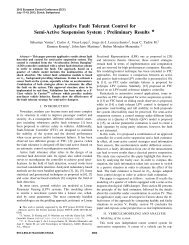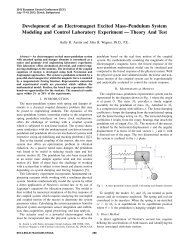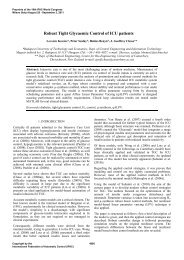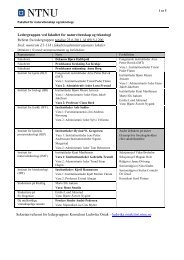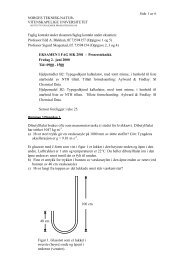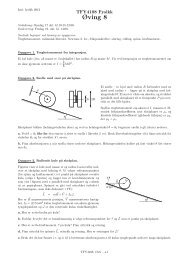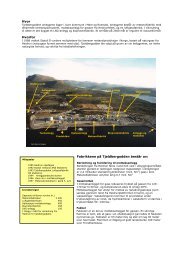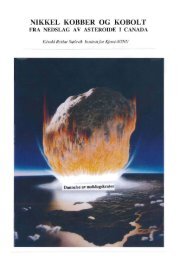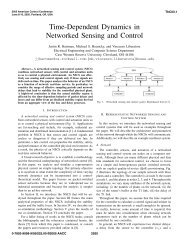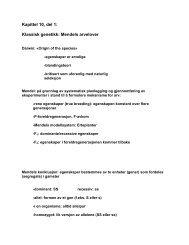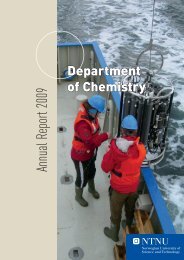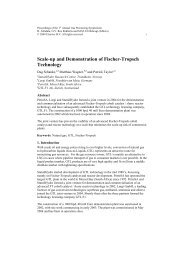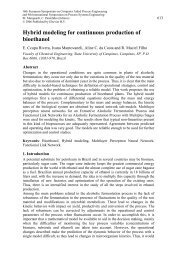CPC VI -- Chemical Process Control VI
CPC VI -- Chemical Process Control VI
CPC VI -- Chemical Process Control VI
Create successful ePaper yourself
Turn your PDF publications into a flip-book with our unique Google optimized e-Paper software.
Nonlinear Model Reduction for Optimization Based <strong>Control</strong> of Transient <strong>Chemical</strong> <strong>Process</strong>es 29<br />
Maas and Pope algorithm, the computational method<br />
reported by Davis and Skodje (1999) could be used to<br />
generate data points of an approximation to M which is<br />
then used to build the correlation (62) as suggested by<br />
Rhodes et al. (1999).<br />
Obviously, this technique can be applied to any other<br />
singular perturbation or projection method. The algebraic<br />
equation (58) of the QSSA or (61) can be sampled<br />
for given values of xs. This data set can then be used to<br />
determine an expression (62) which can be used to eliminate<br />
the fast states xf in (58) or the auxiliary variables<br />
ν in (60).<br />
It should be noted that all the methods discussed in<br />
this section require the partitioning of the original state<br />
vector x into fast and slow variables xf and xs. The<br />
method reported by Robertson and Cameron (1997b)—<br />
though cumbersome—seems to be most suitable for this<br />
purpose.<br />
Remarks on Distributed Parameter Systems<br />
So far, distributed parameter systems have been represented<br />
by a model of type (8) employing either averaging<br />
over a spatial domain as part of the modeling procedure<br />
or by discretizing the spatial coordinates of a partial<br />
differential equation (PDE) model. Hence, the infinitedimensional<br />
model has been first reduced to some potentially<br />
high order model (8) which then may be subject<br />
to model order reduction as reviewed above. Alternatively,<br />
order reduction could directly be applied to the<br />
infinite-dimensional PDE model to avoid often heuristic<br />
finite-dimensional approximate modeling. There is a lot<br />
of literature dealing with this problem which would justify<br />
a review in its own. Only a few references are given<br />
here as a starting point for the interested reader.<br />
The rigorous model reduction approaches for nonlinear<br />
PDE models include Galerkin projection involving<br />
empirical (e.g. Holmes et al., 1996) or modal eigenfunctions<br />
(e.g. Armaou and Christofides, 2000) as well as<br />
weighted residuals methods of various kinds (e.g. Villadsen<br />
and Michelsen, 1978; Cho and Joseph, 1983; Stewart<br />
et al., 1985; Tali-Maamar et al., 1994). Better prediction<br />
quality can usually be obtained if the truncated contributions<br />
in the series expansion are captured by the approximate<br />
inertial manifold (e.g. Christofides and Daoutidis,<br />
1997; Shvartsman and Kevrekidis, 1998; Armaou<br />
and Christofides, 2000). These techniques are closely<br />
related to projection and proper orthogonal decomposition<br />
as discussed above. Singular perturbation techniques<br />
have also been applied directly to PDE models.<br />
For example, Dochain and Bouaziz (1994) propose a low<br />
order model for the exit concentrations of a flow bioreactor.<br />
Extremely compact low order models can be derived<br />
for those distributed parameter systems which show wave<br />
propagation characteristics such as separation and reaction<br />
processes (Marquardt, 1990). The major state vari-<br />
ables comprise the spatial position of the wave front and<br />
some properties of the shape of the wave. This concept<br />
has been applied most notably to fixed-bed reactors<br />
(e.g. Gilles and Epple, 1981; Epple, 1986; Doyle III<br />
et al., 1996) as well as to binary or multi-component as<br />
well as reactive distillation columns (e.g. Gilles et al.,<br />
1980; Marquardt and Gilles, 1990; Hwang, 1991; Han<br />
and Park, 1993; Balasubramhanya and Doyle III, 2000;<br />
Kienle, 2000).<br />
The results available indicate that reduction techniques<br />
for PDE models should be seriously considered<br />
at least in the sense of a first model reduction step in<br />
particular in a plant-wide model reduction problem to<br />
derive an approximate lumped parameter model of type<br />
(8) for some of the process units.<br />
Discussion<br />
The review in this section shows a large variety of nonlinear<br />
model reduction techniques stemming from different<br />
scientific areas. This is largely due to the lack of a<br />
unifying theory which could be used to guide the model<br />
reduction process. Truly nonlinear approaches with a<br />
sound theoretical basis are those singular perturbation<br />
techniques, which rely on some approximation of the attractive<br />
invariant manifold of the dynamical system (e.g.<br />
Duchene and Rouchon, 1996; Rhodes et al., 1999; Davis<br />
and Skodje, 1999) and nonlinear balancing techniques<br />
(Scherpen, 1993, 1996). As always in nonlinear theory,<br />
the computations are tedious or even infeasible—in particular<br />
if large-scale problems have to be tackled. An interesting<br />
alternative are those projection methods which<br />
incorporate the nonlinearity of the system in the reduction<br />
procedure at least to some extent (e.g. Pallaske,<br />
1987; Hahn and Edgar, 1999, 2000). Some theoretical<br />
justification is available from their close relation to a<br />
more general nonlinear theory. POD has gained significant<br />
interest in recent years in particular for very largescale<br />
processes which often occur as a result of discretizing<br />
distributed parameter systems despite their lack of<br />
theoretical foundation.<br />
At this point, there is neither evidence whether any<br />
of the nonlinear model reduction techniques could qualify<br />
as a generic method which gives good results for any<br />
process system, nor are there guidelines available which<br />
of them to prefer for a particular class of process systems.<br />
A selection of results for type (8) models are presented<br />
in Table 1. The reductions presented are those<br />
suggested by the authors to give satisfactory results. A<br />
quantitative comparison is almost impossible and should<br />
not be attempted. Obviously, significant order reduction<br />
has only been achieved for those processes which have<br />
a distributed nature (i.e. the distillation column, fixed<br />
bed reactor, pulp digester and rapid thermal processing<br />
cases in Table 1). In these cases, model reduction based<br />
on nonlinear wave propagation can lead to even higher<br />
levels of reduction. However, in all reported studies, the



